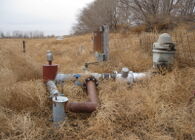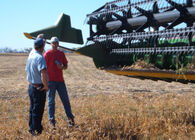Conservation Cost Share Programs

Natural resources districts have a statutory mission to conserve, protect, develop, and manage the natural resources of the state.
One way that the North Platte NRD accomplishes this goal is to work alongside landowners, by cooperating with landowners and the state of Nebraska to provide conservation cost-share programs that combine the financial resources of landowners, the NRD, and the state to provide financial incentives to landowners to protect soil, water, and other resources for the general welfare.
Most of these programs reimburse landowners for a portion of the costs they incur in making improvements that protect resources. These programs include:
- Nebraska Soil and Water Conservation Cost-Share Program (NSWCP)
- Soil Sample Cost Share Project
- Nebraska Buffer Strip Program
- Panhandle No-Till Partnership
Nebraska Soil and Water Conservation Cost-Share Program (NSWCP)
Funded by both District money and the Nebraska Soil and Water Conservation Fund, the Conservation Cost-Share Program reimburses landowners for part of the cost of installing various conservation practices on their land. The cost-share rate is 50 percent of the actual costs up to a set amount with an overall $5000 limit. Landowners contact the USDA Natural Resources Conservation Service (NRCS) for technical assistance in implementing these practices.
Conservation Practices
- Irrigation water management
- Planned grazing systems
- Windbreaks
- Terrace systems & underground outlets
- Water impoundment dams
- Grade stabilization structures
- Irrigation tailwater recovery pits
- Water & sediment control basins
- Grassed waterways
- Diversions
- Livestock water runoff dugouts
- Range seeding or pasture planting
- Critical area planting
- Underground irrigation water return pipe
- Livestock water facilities
- Streambank stabilization
Get a Full List of Cost-Share Practices
Farm Bill
The main instrument of the NRCS is the 2018 Farm Bill and related programs.
Farm Bill Programs
The North Platte NRD works closely with the Natural Resource Conservation Service (NRCS) to help find solutions to natural resource issues. Check with the local USDA and NRD for availability:
- Environmental Quality Incentives Program (EQIP) – Provides technical and financial assistance to agricultural producers to maintain and improve natural resources. Traditional practices, as well as fisheries habitat improvement, are emphasized.
- Agricultural Conservation Easement Program (ACEP)– Under Wetland Reserve Easements (WRE) a part of the Agricultural Conservation Easement Program (ACEP) program. Assists landowners who want to enhance existing wetlands in an environmentally beneficial and cost-effective manner. Participant options include both: cost-share agreements and permanent easements.
- Conservation Reserve Program (CRP)
- Continuous -CRP
Farm Bill News & Deadlines Nebraska NRCS Office & Programs
Soil Sample Cost Share Project
The North Platte NRD submitted a proposal to the Nebraska Environmental Trust and was awarded a matching funds grant to provide funds for a District-wide soil sampling cost-share program. This program was designed to provide an incentive for producers to share sampling data with the NRD to examine the variability of soil fertility within the district. Our intent is to evaluate samples geospatially on a township-wide basis. Applications and information are available at the NPNRD office, and from your local Agronomy supplier.
Click Here for the Application.
To be eligible for the cost share of $25.00 per paired surface (0-6,0-8,0-10, or 0-12 max) and subsoil (to a minimum of 24 inches) samples must meet the following criteria.
- Minimum of 13 probes/ 40 acres blended to make composite surface/subsoil sample.
- Each probe location must be Geo-referenced. Geo-reference points shall not be provided to the NRD.
- Surface sample must be analyzed as a complete sample.
- Subsoil samples must be analyzed for Nitrogen only.
- Samples must be identified to the quarter section. Example NE4-21,21N,51W, Morrill County
- Analysis must be conducted by a certified soil laboratory.
- Samples from both irrigated and dryland are eligible for cost share.
Please direct any questions or concerns to Todd Filipi or Ken Ridgeway at the NPNRD 308-632-2749
Nebraska Buffer Strip Program
Landowners can enroll cropland adjacent to streams and other bodies of water in the Nebraska Buffer Strip Program by signing up at local USDA Natural Resources Conservation Service (NRCS) offices.
The program provides annual, per-acre payments to landowners who plant buffer strips along the banks of streams and ponds. Buffer strips can reduce the amount of silt and agricultural chemicals that enter surface waters. Payments are available for new buffer strips and existing buffer strips established after January 1, 1996.
The NRCS will evaluate each application to determine eligibility and payment amount. If the NRCS determines an application to be eligible and the application is approved by the NRD and Nebraska Department of Agriculture (NDA), the producer may enter into a contract with the local natural resources district. Funding is determined on a point system established by the Nebraska Department of Agriculture.
The Nebraska Buffer Strip Program was created by the Nebraska Legislature in 1998 and is funded through the Nebraska Department of Agriculture. Fees assessed on all pesticides registered for use in Nebraska fund the program.
Here are some of the general terms of the Buffer Strip Program. Contracts must run for at least five years, but no more than 10 years.
- Non-irrigated cropland rates are determined using the CRP rental rates for soil types found in the area. Irrigated rates are a flat rate of $150 per acre, regardless of soil type or geographic location. Other program payments are subtracted from the maximum payment allowed to determine the Nebraska Buffer Strip Program (NBSP) payment.
- Limited haying and grazing are allowed.
- Buffer strips can include grass, forb, tree, and shrub species according to NRCS guidelines.
- Buffer strips will be between 20 feet and 180 feet wide.
- The minimum buffer strip area is 1 acre; there is no maximum.
- The NRD will inspect buffer strips to ensure compliance during the five to 10-year contract period.
Read More about the NE Buffer Strip Program
View Mark Watson's Weekly No-Till Notes
The Panhandle No-Till Partnership was formed in 2008 as a joint effort between the Natural Resources Conservation Service (NRCS), the Panhandle Resource Conservation & Development, Inc. (RC&D), and the North Platte NRD, South Platte NRD, and Upper Niobrara-White NRD.
Additional Conservation Cost Share Information
For sign-up information on any of these Cost-Share programs, contact the North Platte NRD at (308) 632-2749.
Note: The cost-share programs of the North Platte Natural Resources District, such as conservation trees, cost-share, and others, are available only within the North Platte NRD.
Our Partners
The North Platte NRD often works with other agencies and organizations to implement projects and programs, including:
- The North Platte NRD works with the Natural Resources Conservation Service to provide cost-share and resources management programs.
- Natural Resources Conservation Service - technical services and administration for many NRD programs.
- NRCS Resource Needs and Concerns page here.
- Nebraska Department of Natural Resources - funding for flood control and soil and water conservation projects
- Nebraska Department of Environmental Quality - regulatory guidance and funding for pollution control efforts
- Nebraska Game and Parks Commission - funding and administration for wildlife habitat projects
Additional Partners
- University of Nebraska-Lincoln Extension
- Nebraska Forest Service
- Other NRDs, cities, counties, and many local organizations.
Gallery
Click image to view larger.


